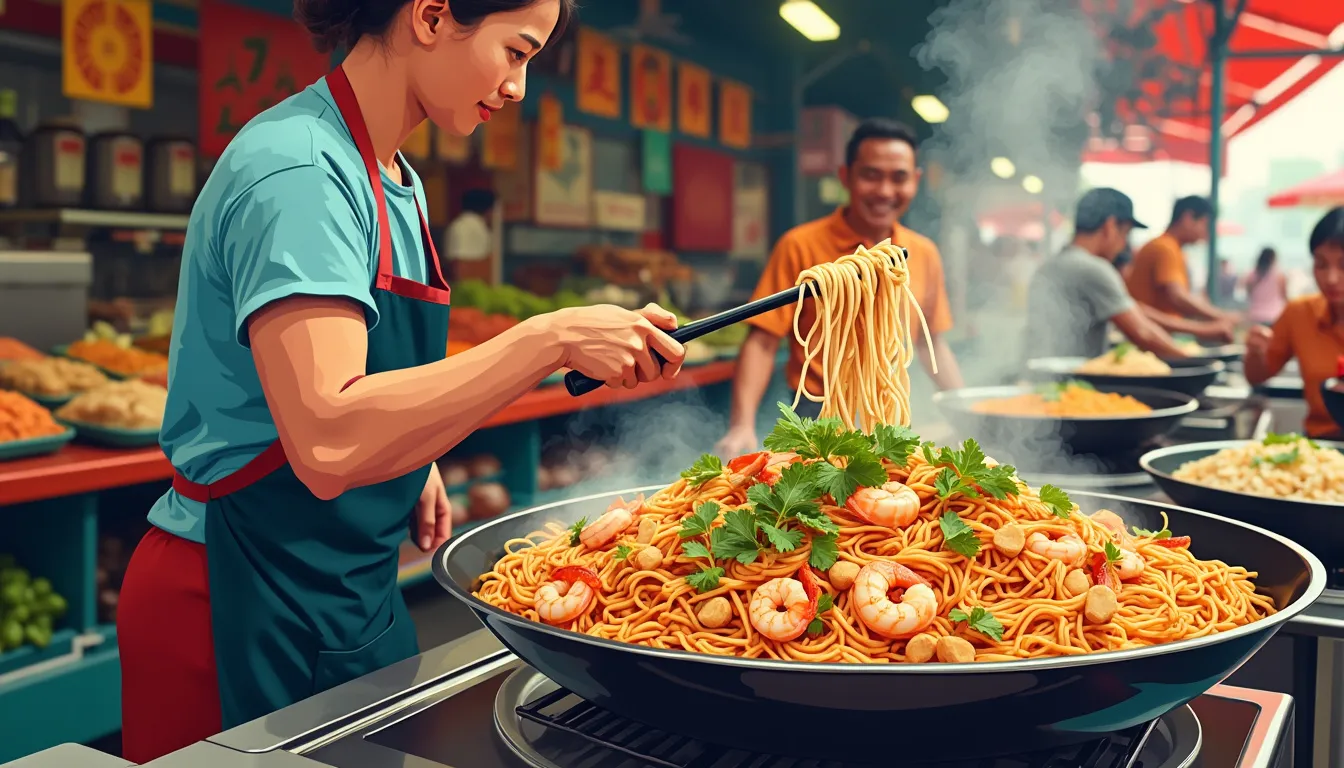Introduction
Few dishes capture the essence of Thai cuisine as perfectly as Pad Thai. This iconic street food is renowned for its harmonious blend of sweet, sour, salty, and umami flavors. But achieving the authentic taste and texture of traditional Pad Thai can be a challenge, especially for those unfamiliar with its essential ingredients and cooking techniques. In this ultimate guide, we’ll take you through everything you need to know to master the art of making authentic Pad Thai at home.
From understanding the key ingredients like rice noodles and tamarind paste to perfecting the stir-frying process, this comprehensive guide covers it all. Whether you’re a seasoned cook or a beginner in the kitchen, you’ll find step-by-step instructions and valuable tips to ensure your Pad Thai turns out just right every time. Along the way, we’ll also address common mistakes and pitfalls to avoid, so you can confidently recreate this beloved dish in its most authentic form.
Ready to embark on a culinary adventure that brings the vibrant flavors of Thailand to your own kitchen? Let’s dive into the essential components that make Pad Thai a global favorite.
Essential Ingredients for Authentic Pad Thai
Understanding Key Ingredients
One of the secrets to crafting an authentic Pad Thai lies in using the right ingredients. This classic Thai dish is celebrated for its balance of sweet, sour, salty, and spicy flavors, and each component plays a crucial role in achieving its distinctive taste. Below are the essential ingredients that you must include:
Rice Noodles
First and foremost, Pad Thai requires rice noodles. These noodles, made from rice flour and water, have a chewy texture that absorbs the rich flavors of the sauce beautifully. Make sure to use thin, flat rice noodles (often labeled as Pad Thai noodles) for the most authentic experience. Soak the noodles in warm water until they become pliant but not mushy. This helps to maintain their integrity during stir-frying, ensuring they don’t break apart.
Tamarind Paste
Tamarind paste is a critical ingredient that provides the signature tangy flavor in Pad Thai. Made from the pulp of the tamarind fruit, this paste adds a unique sour note that balances out the sweetness and saltiness of the dish. You can find tamarind paste in most Asian grocery stores. If unavailable, you can substitute it with a mix of lime juice and sugar, although this won’t replicate the complex flavor profile of tamarind.
Fish Sauce
Fish sauce is another cornerstone ingredient. Made from fermented fish, this sauce imparts a deep umami flavor that enhances the savory elements of Pad Thai. It’s salty and slightly briny, working in harmony with the other ingredients to create a rich, multidimensional taste. Be sure to use a high-quality fish sauce to avoid overly pungent notes that can overpower the dish.
Palm Sugar
Palm sugar is used to introduce sweetness to Pad Thai. Derived from the sap of sugar palm trees, it has a caramel-like taste and adds a beautiful depth of flavor compared to regular white sugar. It’s typically sold in solid blocks, which can be grated or melted into sauces. If palm sugar isn’t available, brown sugar makes a suitable substitute, although the flavor will be slightly different.
Additional Ingredients: Protein, Vegetables, and Garnishes
Beyond the core components, Pad Thai is a highly versatile dish that can accommodate various proteins, vegetables, and garnishes to enhance its flavor and texture. Here are some common additions:
Protein
The most popular proteins in Pad Thai are shrimp and chicken, but tofu is a great vegetarian alternative. The key is to cut the protein into bite-sized pieces so that it cooks quickly and evenly in the wok. Marinating the protein briefly in a bit of fish sauce or soy sauce can help infuse more flavor.
Vegetables
While Pad Thai doesn’t contain a lot of vegetables, the ones it does include add vital texture and color. Common choices are bean sprouts, which offer a crisp bite, and spring onions, which provide a fresh, slightly pungent taste. Other vegetables like baby bok choy, bell peppers, or shredded carrots can also be added according to your preference.
Garnishes
The final garnishes for Pad Thai are what often elevate it from a simple stir-fry to a gourmet dish. Crushed peanuts add a delightful crunch and nutty flavor. Fresh cilantro and lime wedges introduce bright, zesty elements that contrast beautifully with the rich sauce. Don’t forget a sprinkle of chili flakes if you like it spicy, and a handful of crispy fried shallots can add another layer of flavor and texture.
Combining these ingredients thoughtfully will set you on the right path to making authentic Pad Thai. Each component, from the chewy rice noodles to the tangy tamarind paste, works together to create a harmonious balance of flavors that is truly iconic in Thai cuisine.
Step-by-Step Cooking Instructions for Pad Thai
Preparing Your Ingredients: Tips and Tricks
Before diving into cooking, it’s crucial to have all your ingredients prepped and ready. This not only makes the cooking process smoother but also ensures that each component of your Pad Thai is cooked to perfection. Here’s how to prepare your ingredients effectively:
- Rice Noodles: Soak them in warm water for about 20-30 minutes until they are pliable but not too soft.
- Proteins: If you’re using shrimp, chicken, or tofu, make sure to cut them into bite-sized pieces for even cooking.
- Vegetables: Julienne your carrots, slice green onions, and chop any other vegetables you’re including.
- Sauces and Pastes: Pre-mix tamarind paste, fish sauce, and palm sugar together to streamline the cooking process.
- Garnishes: Have your crushed peanuts, lime wedges, and fresh cilantro ready for the final touches.
Cooking the Perfect Pad Thai Noodles
The texture of the noodles is a critical element in making delicious Pad Thai. Here’s how to cook them to perfection:
- Boil water in a large pot and then remove it from the heat.
- Add the soaked rice noodles and let them sit for about 3-5 minutes or until they’re just tender but still firm (al dente).
- Drain the noodles and rinse them with cold water to stop the cooking process.
- Toss them with a little oil to prevent sticking and set aside.
Combining Flavors: The Art of Stir-Frying Pad Thai
Now that your ingredients are prepped and your noodles are ready, it’s time to combine everything in a wok. Stir-frying is an essential technique in achieving that authentic Pad Thai flavor:
- Heat 2 tablespoons of oil in a large wok over medium-high heat.
- Add your protein (shrimp, chicken, or tofu) and cook until done. Remove and set aside.
- Add a little more oil if needed and then stir-fry your garlic and onions until fragrant.
- Push the garlic and onions to one side of the wok and add your beaten eggs to the opposite side. Scramble until cooked through and then mix everything together.
- Add the softened noodles and pour in your pre-mixed tamarind, fish sauce, and palm sugar mixture. Stir-fry quickly to combine all elements.
- Return your cooked protein to the wok and add any vegetables. Continue to stir-fry until everything is well-coated and heated through.
Final Touches: Garnishing Your Pad Thai Dish
Garnishing adds the final flourish to your dish, bringing in layers of texture and flavor:
- Crushed Peanuts: Sprinkle generously for a crunchy texture.
- Bean Sprouts: Add them just before serving for a fresh, crispy bite.
- Lime Wedges: A squeeze of lime juice enhances the overall flavors and adds a citrusy brightness.
- Fresh Cilantro: Garnish with chopped cilantro for added freshness.
- Red Chili Flakes: For those who enjoy a bit of heat, a sprinkle of red chili flakes can add a spicy kick.
By following these step-by-step cooking instructions, you will be able to create an authentic and delightful Pad Thai that’s sure to impress. Remember, the key to a great Pad Thai lies in preparing your ingredients meticulously, cooking your noodles to the perfect texture, mastering the stir-frying technique, and finishing with a thoughtful garnish.
Common Mistakes to Avoid When Making Pad Thai
While making authentic Pad Thai can be a rewarding culinary experience, it’s easy to run into a few common pitfalls along the way. These mistakes can significantly impact the taste and texture of your final dish. Here, we’ll explore some of the most frequent errors and how you can avoid them to ensure that your Pad Thai is nothing short of perfection.
Overcooked or Under-cooked Noodles
One of the main components of Pad Thai is the rice noodles, and getting them just right is crucial. Overcooked noodles can become mushy and lose their distinctive texture, while under-cooked noodles can be hard and unpleasant to eat.
Tip: Follow the package instructions carefully when soaking your rice noodles. Usually, soaking them in hot water for around 20-30 minutes should suffice. Once they are pliable but still slightly firm (al dente), drain and rinse them with cold water to stop the cooking process. Remember, they will cook further in the wok, so it’s important not to over-soak them beforehand.
Imbalance of Flavors
Authentic Pad Thai is a harmonious blend of sweet, sour, salty, and umami flavors. Achieving this balance is crucial for an authentic taste. An imbalance can make your Pad Thai taste too salty, too sour, or too sweet, and ruin the dish.
Tip: Taste as you go. The key ingredients that contribute to the flavor profile are tamarind paste, fish sauce, and palm sugar. Start with smaller amounts and adjust to your preference. For example, if you prefer a tangier dish, you can add a bit more tamarind paste. Personalizing the flavors while maintaining balance is essential for creating an authentic Pad Thai.
Incorrect Ingredient Substitutes
While it can be tempting to replace traditional ingredients with more readily available ones, doing so can greatly alter the taste of your Pad Thai. Substitutes like white sugar for palm sugar or soy sauce for fish sauce can lead to a dish that doesn’t have the authentic flavor you’re aiming for.
Tip: Make an effort to use authentic ingredients. Tamarind paste, palm sugar, and fish sauce are now widely available in many supermarkets and Asian grocery stores. If you must substitute, choose the closest alternatives and adjust your seasoning to make up for the flavor differences. For instance, a mix of brown sugar and molasses can imitate the rich sweetness of palm sugar.
Skipping Key Steps in the Traditional Method
The traditional method of making Pad Thai involves several key steps that should not be skipped for convenience. Each step, from soaking the noodles to stir-frying ingredients in the correct sequence, ensures that the dish comes together correctly.
Tip: Follow the recipe methodically. Start by preparing all your ingredients before you begin cooking. Stir-fry the garlic and shallots first to infuse the oil with their flavors, then add the protein, followed by the noodles, and finally the sauce and vegetables. This sequence ensures that each ingredient is cooked to perfection and that the flavors meld together seamlessly.
By being mindful of these common mistakes and following these tips, you’ll be well on your way to preparing a delicious and authentic Pad Thai. Remember, achieving the authentic flavor and texture comes down to attention to detail and a willingness to perfect your culinary techniques.
Conclusion
Mastering the art of making authentic Pad Thai is an immensely rewarding experience that brings the vibrant flavors of Thailand right into your kitchen. By familiarizing yourself with the essential ingredients such as rice noodles, tamarind paste, fish sauce, and palm sugar, you lay a solid foundation for an authentic dish. The step-by-step cooking instructions ensure you handle each element with care, from pre-soaking the noodles to perfecting the stir-fry technique, culminating in a delightful harmony of flavors and textures.
It’s crucial to be mindful of common mistakes like overcooking the noodles or skimping on key ingredients that can affect the taste and authenticity of your Pad Thai. By following the traditional methods and making thoughtful ingredient choices, you can avoid these pitfalls and create a dish that is not only delicious but true to its cultural roots.
As you refine your skills, feel free to experiment with different proteins, vegetables, and garnishes to personalize your Pad Thai while maintaining its authentic essence. Whether you are cooking for a family dinner or a friendly gathering, your ability to whip up a plate of authentic Pad Thai will certainly impress and delight. Happy cooking!







